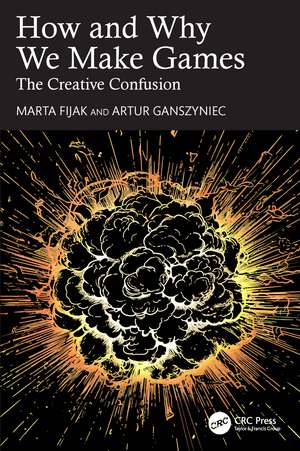How and Why We Make Games: The Creative Confusion
Autor Marta Fijak, Artur Ganszyniecen Limba Engleză Paperback – aug 2024
The book analyzes why we should put politics in our games and how hyperrealism may be a trap. It also proposes a new framework for thinking about game narrative and a different paradigm for the production altogether. Topics tackled are approached from a multidisciplinary perspective, so be prepared to read both about Peter Paul Rubens and John Carmack. There are also graphs, system rhetorics discussions, and the market reality—stakeholders, return on investments, and the gaming bubble bursting.
This book is written for readers passionate about the craft of making games, including journalists and industry professionals. It offers a more humanistic perspective on games, presented by experienced writers who know the intricacies of game development.
| Toate formatele și edițiile | Preț | Express |
|---|---|---|
| Paperback (1) | 232.20 lei 3-5 săpt. | +11.38 lei 7-13 zile |
| CRC Press – aug 2024 | 232.20 lei 3-5 săpt. | +11.38 lei 7-13 zile |
| Hardback (1) | 701.30 lei 6-8 săpt. | |
| CRC Press – aug 2024 | 701.30 lei 6-8 săpt. |
Preț: 232.20 lei
Preț vechi: 290.25 lei
-20% Nou
Puncte Express: 348
Preț estimativ în valută:
44.43€ • 48.41$ • 37.44£
44.43€ • 48.41$ • 37.44£
Carte disponibilă
Livrare economică 02-16 aprilie
Livrare express 19-25 martie pentru 21.37 lei
Preluare comenzi: 021 569.72.76
Specificații
ISBN-13: 9781032343327
ISBN-10: 103234332X
Pagini: 146
Ilustrații: 14
Dimensiuni: 156 x 234 x 10 mm
Greutate: 0.22 kg
Ediția:1
Editura: CRC Press
Colecția CRC Press
Locul publicării:Boca Raton, United States
ISBN-10: 103234332X
Pagini: 146
Ilustrații: 14
Dimensiuni: 156 x 234 x 10 mm
Greutate: 0.22 kg
Ediția:1
Editura: CRC Press
Colecția CRC Press
Locul publicării:Boca Raton, United States
Public țintă
ProfessionalNotă biografică
Marta Fijak – making games since 2013. With a master's in experimental biology and an engineering degree in computer science, she decided to dedicate her life to games instead. Tried every form of game development, from basement indie with 20 players to a BAFTA-nominated game with ~2 million players, to F2P with ~10 million players. Has been a gameplay programmer, system and technical designer, and eventually a lead designer and a creative director. Recently, and not under NDA, she worked (a lot) on Frostpunk and (a little) on Rimworld. Teaches game design at the Warsaw Film School, consults on games, and just in general, can not shut up about them.
Artur Ganszyniec – making games since 2006. Data analyst by education, storyteller by choice, designer by trade, autistic by birth. Worked on AAA games, overseeing the story for the first two The Witcher games, and worked on ethical mobile F2P games, and artistic indie darlings. Teaches game design at the Lodz University of Technology, consults on games, and works for the Polish game industry as a part of the Polish Gamedev Workers Union.
Artur Ganszyniec – making games since 2006. Data analyst by education, storyteller by choice, designer by trade, autistic by birth. Worked on AAA games, overseeing the story for the first two The Witcher games, and worked on ethical mobile F2P games, and artistic indie darlings. Teaches game design at the Lodz University of Technology, consults on games, and works for the Polish game industry as a part of the Polish Gamedev Workers Union.
Cuprins
Chapter 1: Games as a Medium. Chapter 2: Why Do People Make Games. Chapter 3: The Myth of the Universal Audience. Chapter 4: Traps of Realism. Chapter 5: Authorial Voice and Intent in System Design. Chapter 6: The Topography of Narrative. Chapter 7: Playing with Authorship. Chapter 8: Why Games Will Always Be Political. Chapter 9: Author as a Group Entity: How It Feels to Be One of 500 Voices. Chapter 10: Slow Games. Chapter 11: Games of the End Times. Index
Descriere
This book delves into the intricate realms of games and their creation, examining them through cultural, systemic, and, most notably, human lenses. It explores diverse themes like authorship, creative responsibility, the tension between games as a product and games as a form of cultural expression, and the myth of a universal audience.
